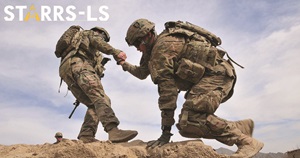By James A. Naifeh, Ph.D. and Holly B. Herberman Mash, Ph.D.
Sept. 17, 2020
 PHCoE graphic
PHCoE graphic
Since 2009, a team of investigators at universities across the U.S. have carried out the Army Study to Assess Risk and Resilience in Servicemembers (Army STARRS) to improve understanding of suicidal thoughts and behaviors among Army soldiers. Combining more than a billion Army and Defense Department records with detailed questionnaires that were completed by more than 100,000 soldiers, Army STARRS is the largest study of suicide risk and resilience ever conducted in the U.S. military. Additional information about Army STARRS, now called STARRS-LS (for "longitudinal study"), is available at starrs-ls.org.
Among many other findings, Army STARRS has contributed to our knowledge of nonfatal suicide attempts during deployment and found that:
These findings suggest that it is important for clinicians to remain alert to:
-
Factors that may influence higher risk among women, such as gender differences related to assignments, training, advancement/promotion, harassment, and sexual assault
-
The possibility that marriage increases rather than decreases risk during deployment
-
Challenges that may be faced by deploying early in one's career, such as lower perceived preparedness and Army acculturation
-
The influence of novel and unpredictable weapons on threat perception and stress
In addition to addressing the question of who is at risk during deployment, it is also important to identify when soldiers are at risk. Army STARRS examined suicide attempt rates based on time in-theater and found that:
-
Monthly rates among active component Army soldiers increased from the start of deployment, reaching a peak during the sixth month, and then gradually decreasing through the 12th month of deployment
-
The same pattern was found among deployed Army Guard and reserve soldiers, with risk increasing from the start of deployment to a peak in the fifth month, followed by decreasing risk through the 12th month
These findings converge with other research to indicate that the middle phase of deployment may be the most emotionally and psychologically difficult period for soldiers in-theater. The Army's own findings, based on Iraq and Afghanistan deployment survey data, indicate that mid-deployment corresponds to soldiers' highest rates of self-reported depression, anxiety, acute stress, and suicide ideation and lowest rates of self-reported individual and unit morale.
It is difficult to know why the mid-deployment phase is so challenging for soldiers. It may be that suicide risk increases during the first half of deployment as stressors accumulate, from combat exposure to the daily hassles of life in-theater to strain on romantic and family relationships due to separation. If true, why does risk then decline during the latter half of deployment (even as a soldier's cumulative exposure to stressors grows)? Could mid-deployment be the turning point at which soldiers begin to look forward to returning home? Could adaptation to the challenges of deployment take several months, after which risk is decreased?
We do not yet have answers to these questions, but we will continue to strive to improve our understanding of psychological and behavioral changes over the course of deployment for Army soldiers. For mental health providers supporting Army soldiers in-theater, it may be valuable to consider which phase of deployment a soldier is in when assessing risk for suicidal behavior and other adverse emotional and behavioral outcomes. In addition, deployed soldiers may benefit from preventive interventions targeted to the high-risk period of mid-deployment.
More work is needed to determine whether these findings related to Army soldier mid-deployment risk are applicable only to specific periods of the wars in Iraq and Afghanistan or to deployments of a specific length. It is also important to determine whether risk for suicide attempts (and other adverse mental and behavioral health outcomes) is highest during the middle phase of other, non-combat deployments (e.g., humanitarian, emergency), which have their own unique characteristics and stressors. Effective mental health intervention will depend, in part, on understanding how the psychological and emotional impacts of deployment change and peak over the course of different types of deployments. Finally, more work is needed to determine whether these finds related to Army soldiers are generalizable to the Navy, Air Force, and Marine Corps service members as well.
Dr. Naifeh is a research associate professor in the Department of Psychiatry at the Uniformed Services University of the Health Sciences, a scientist at the Center for the Study of Traumatic Stress, and a research psychologist at the Henry M. Jackson Foundation for the Advancement of Military Medicine, Inc. He is an Army STARRS/STARRS-LS investigator and collaborator, and his primary areas of research include suicidal behavior and traumatic stress in military populations.
Dr. Herberman Mash is a research associate professor in the Department of Psychiatry at the Uniformed Services University of the Health Sciences, a scientist at the Center for the Study of Traumatic Stress, and a research psychologist at the Henry M. Jackson Foundation for the Advancement of Military Medicine, Inc. She is an investigator and collaborator on Army STARRS/STARRS-LS, and her primary research interests include risk and protective factors for complicated grief and mental disorders following traumatic events, suicidal behavior, and alcohol use disorders in military service members and civilians.
The opinions and assertions expressed herein are those of the author(s) and do not necessarily reflect the official policy or position of the Uniformed Services University, the Department of Defense or the Henry M. Jackson Foundation of the Advancement of Military Medicine, Inc.